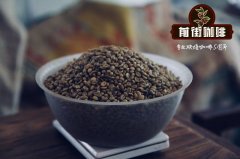The sour taste of coffee comes from the benefits of acid chlorogenic acid in coffee the role of chlorogenic acid in coffee

Professional coffee knowledge exchange more coffee bean information please follow the coffee workshop (Wechat official account cafe_style)
Caffeic acid (English: Caffeic acid) is an organic compound belonging to hydroxycinnamic acid, which has both phenolic hydroxyl and acrylic acid functional groups. Caffeic acid is a key intermediate of lignin, one of the main components of biosynthetic plant biomass and its residues, so it exists widely in a variety of plants. It can be dissolved in hot water and ethanol and slightly soluble in cold water. It is yellow-white crystal at room temperature.
Caffeic acid is synthesized by hydroxylation of coumarate (esterified side chain alcohol) of chlorogenic acid. This hydroxylation process produces caffeic acid esters of shikimic acid, which is then converted to chlorogenic acid. It is the precursor of ferulic acid, coniferol and mustard alcohol, which are important structural units for the formation of lignin. Many plants can produce caffeic acid and its derivative caffeic acid phenylethanol ester.
Since the 21st century, there have been a large number of studies on the health benefits of coffee in medicine. at first, caffeine is widely known, and then since 2011, the most eye-catching rising star is the "chlorogenic acid" in the polyphenol family. There are no fewer than a thousand research papers.
This makes green coffee popular in many countries in Europe, the United States and Japan, and it is even more used to add chlorogenic acid to health care, weight loss and beauty products. Here we reveal to you why chlorogenic acid can be so widely used. Sort out ten good things that people have to know about chlorogenic acid!
What on earth is chlorogenic acid? What is the role in coffee?
In order to maintain the normal function of the human body, in addition to the five major nutrients, two new types of food fiber and phytochemicals have been added. Chlorogenic acid is one of the phytochemicals, which exists in many vegetables and fruits. It is also polyphenols. It is often heard that catechins are tea polyphenols, red wine polyphenols are found in red wine, and chlorogenic acid is the polyphenols in coffee. These polyphenols have amazing antioxidant capacity and have been proved to be good for the human body by medicine. It is recommended to take them every day.
Chlorogenic acid is the key to the charm of coffee: in terms of color, it is one of the color factors of coffee; in terms of taste, it is one of the factors that form the bitterness and aroma of coffee.
Chlorogenic acid is the self-defense force that protects coffee trees: among coffee fruits, it can reduce the damage of ultraviolet rays to coffee trees, and at the same time prevent and control diseases and insect pests.
Decrypt the top ten benefits: health care, slimming, beauty, three major areas of new darling-chlorogenic acid
END
For more professional coffee exchanges, please scan the code and follow Wechat: qiannjie
Important Notice :
前街咖啡 FrontStreet Coffee has moved to new addredd:
FrontStreet Coffee Address: 315,Donghua East Road,GuangZhou
Tel:020 38364473
- Prev

Can coffee lose weight? Who should drink less coffee?
Professional coffee knowledge exchange more coffee bean information Please pay attention to the coffee workshop (Wechat official account cafe_style) Coffee is a highly controversial drink, as the caffeine contained may lead to addiction, eating too much may cause palpitations, insomnia and other problems. However, the well-known Japanese dietitian Qianhe Anzhong confirmed with various data that, in fact, three cups of coffee a day, what kind of living habits
- Next

Is caffeine the source of coffee bitterness? The bitterness of coffee comes from roasting
For more information on coffee beans, please follow the coffee workshop (official Wechat account cafe_style). Everyone thinks that caffeine is the reason for the bitter taste of coffee, but in fact, caffeine accounts for only 10% of the bitter ingredients. As we said earlier, the concentration of caffeine in roasted beans is not affected by the degree of roasting, and decaf also tastes bitter, so we
Related
- Beginners will see the "Coffee pull flower" guide!
- What is the difference between ice blog purified milk and ordinary milk coffee?
- Why is the Philippines the largest producer of crops in Liberia?
- For coffee extraction, should the fine powder be retained?
- How does extracted espresso fill pressed powder? How much strength does it take to press the powder?
- How to make jasmine cold extract coffee? Is the jasmine + latte good?
- Will this little toy really make the coffee taste better? How does Lily Drip affect coffee extraction?
- Will the action of slapping the filter cup also affect coffee extraction?
- What's the difference between powder-to-water ratio and powder-to-liquid ratio?
- What is the Ethiopian local species? What does it have to do with Heirloom native species?

